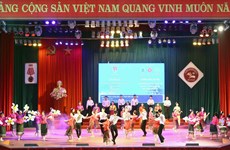Distinctive timber houses drawcard in Bac Kan
Visitors walking to Yen Lac town in the northern province of Bac
Kan 's Na Ri district will discover scores of unusual old houses
made of timber from the nghien (burretiodendron hsienmu) tree, an
endangered native of Vietnam and China.
Visitors walking to Yen Lac town in the northern province of Bac
Kan 's Na Ri district will discover scores of unusual old houses
made of timber from the nghien (burretiodendron hsienmu) tree, an
endangered native of Vietnam and China.
Residents say that most of the people who live in the quarter are Chinese-Vietnamese which could explain why the houses are different from native structures. When they were built more than a half-century ago, these tubular houses were placed very close to one another. At first, only a few people in the district built houses in this style but then they gained popularity and others began to copy the architectural style.
An ethnic Nung woman named Luong Thi Phung, 80, who was born and raised in the quarter, says: "My house, made of nghien wood, was built 60 years ago. Even now, termites and worms stay away from this wood. At that time, it took four people one week to manoeuvre one nghien wood log to use for construction. It took us years to build our house. Other residents in the quarter imitated us and built similar houses, finally making the long row of houses that is here now. That's why this quarter was named the old quarter."
A courtyard and street were constructed in the middle of this wide quarter. People use the public space for a variety of activities, such as selling goods in the morning, taking the air and playing football in the afternoon.
Sitting in the sunshine by a cooking fire on a cold day, Nong Thi Hinh and Ly Thi Nong are talking as they sell banh te (rice cake filled with stir-fried onion) and look after three of their grandchildren as they play.
Hinh smiles and says that her cakes are very cheap, costing only 1,000 VND each. She adds that her sales help her not only earn some money but also allows her to enjoy the fresh air. Talking with her neighbour Nong at noon has become a habit, she says.
Its location 550m above sea level and poor road access keep Na Ri district quite isolated in the eastern part of Bac Can. It is 80km from the centre of Bac Kan Town to the district. In order to reach Yen Lac town, visitors must travel across Ang Toong mountain pass along a steep and narrow road. The population in Yen Lac is 37,000, primarily made up of people from several minorities group such as Mong, Tay , Nung, Kinh and Dao. Primary source of income is agriculture and forestry because commercial services are limited.
As she explains the name of the district, Nong, 68, says that in the Thai language, Na Ri is spelled as Na Sli, which translates as "long rice paddy", describing high mountains, deep valleys and field paddies along the river. She says that it turns into Na Ri when spelled in Vietnamese.
The outside space in each of these old quarter houses is used to receive guests. A narrow corridor on the left runs to the inside and two or three bedrooms are on the right. A kitchen, stable for cattle and toilet are located at one end of the house. An attic for storage is located in the top part of the house which can also be used as a bedroom if there are many children. The most solemn area of the house is the living room, which contains the altar.
Elders say that at first, the roofs of the houses were covered by earthernware tiles arranged as fish scales but today corrugated sheet metal, heat-resistant plastic tiles and other materials are the norm. However, most of the houses have been roofed with traditional ‘ying-yang' tiles (each tile is layered on top of a gap that is created by two bottom tiles which are layered a few centimetres apart from each other).
Residents believe the thin traditional tiles and the method of placing them upside-down make the houses cool in the summer. Phung's daughter-in-law Ly Thi Binh says they have to replace the tiles every few decades but the houses always remain free of termites and worms. If they decided to move to another location, they can disassemble their houses and put them back together, she says.
At this time, there is no project to develop the old quarter as a tourist destination. An official of the Bac Kan Department of Culture, Sports and Tourism says that not many people, particularly foreign tourists, visit the area. Perhaps it will attract more tourists once a project to boost tourism in the nearby Nang Tien Cave is implemented. /.
Residents say that most of the people who live in the quarter are Chinese-Vietnamese which could explain why the houses are different from native structures. When they were built more than a half-century ago, these tubular houses were placed very close to one another. At first, only a few people in the district built houses in this style but then they gained popularity and others began to copy the architectural style.
An ethnic Nung woman named Luong Thi Phung, 80, who was born and raised in the quarter, says: "My house, made of nghien wood, was built 60 years ago. Even now, termites and worms stay away from this wood. At that time, it took four people one week to manoeuvre one nghien wood log to use for construction. It took us years to build our house. Other residents in the quarter imitated us and built similar houses, finally making the long row of houses that is here now. That's why this quarter was named the old quarter."
A courtyard and street were constructed in the middle of this wide quarter. People use the public space for a variety of activities, such as selling goods in the morning, taking the air and playing football in the afternoon.
Sitting in the sunshine by a cooking fire on a cold day, Nong Thi Hinh and Ly Thi Nong are talking as they sell banh te (rice cake filled with stir-fried onion) and look after three of their grandchildren as they play.
Hinh smiles and says that her cakes are very cheap, costing only 1,000 VND each. She adds that her sales help her not only earn some money but also allows her to enjoy the fresh air. Talking with her neighbour Nong at noon has become a habit, she says.
Its location 550m above sea level and poor road access keep Na Ri district quite isolated in the eastern part of Bac Can. It is 80km from the centre of Bac Kan Town to the district. In order to reach Yen Lac town, visitors must travel across Ang Toong mountain pass along a steep and narrow road. The population in Yen Lac is 37,000, primarily made up of people from several minorities group such as Mong, Tay , Nung, Kinh and Dao. Primary source of income is agriculture and forestry because commercial services are limited.
As she explains the name of the district, Nong, 68, says that in the Thai language, Na Ri is spelled as Na Sli, which translates as "long rice paddy", describing high mountains, deep valleys and field paddies along the river. She says that it turns into Na Ri when spelled in Vietnamese.
The outside space in each of these old quarter houses is used to receive guests. A narrow corridor on the left runs to the inside and two or three bedrooms are on the right. A kitchen, stable for cattle and toilet are located at one end of the house. An attic for storage is located in the top part of the house which can also be used as a bedroom if there are many children. The most solemn area of the house is the living room, which contains the altar.
Elders say that at first, the roofs of the houses were covered by earthernware tiles arranged as fish scales but today corrugated sheet metal, heat-resistant plastic tiles and other materials are the norm. However, most of the houses have been roofed with traditional ‘ying-yang' tiles (each tile is layered on top of a gap that is created by two bottom tiles which are layered a few centimetres apart from each other).
Residents believe the thin traditional tiles and the method of placing them upside-down make the houses cool in the summer. Phung's daughter-in-law Ly Thi Binh says they have to replace the tiles every few decades but the houses always remain free of termites and worms. If they decided to move to another location, they can disassemble their houses and put them back together, she says.
At this time, there is no project to develop the old quarter as a tourist destination. An official of the Bac Kan Department of Culture, Sports and Tourism says that not many people, particularly foreign tourists, visit the area. Perhaps it will attract more tourists once a project to boost tourism in the nearby Nang Tien Cave is implemented. /.













